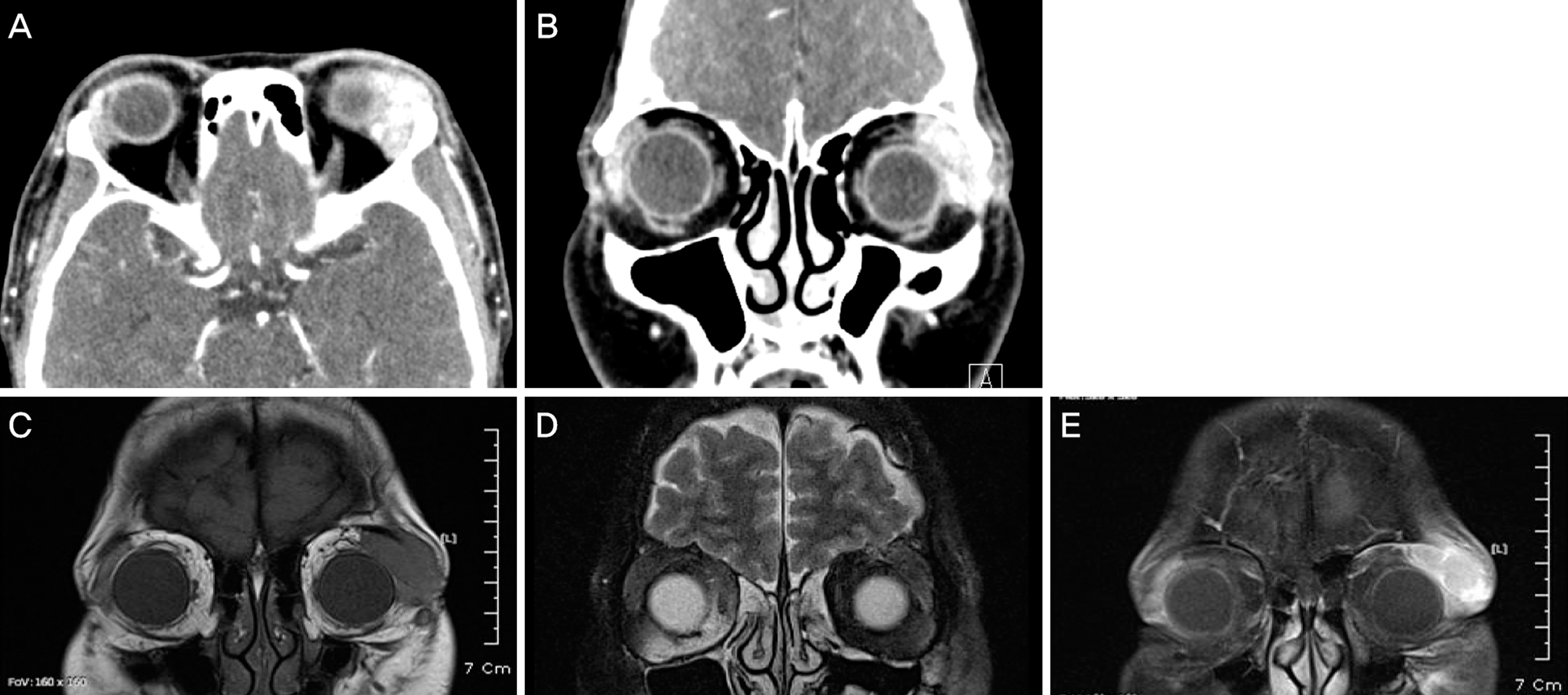J Korean Ophthalmol Soc.
2017 Feb;58(2):216-221. 10.3341/jkos.2017.58.2.216.
Multiple Solitary Plasmacytomas Presenting with Painful Erythematous Swelling of the Upper Eyelid
- Affiliations
-
- 1Department of Ophthalmology, Gachon University Gil Medical Center, Incheon, Korea. cmj@gilhospital.com
- KMID: 2369472
- DOI: http://doi.org/10.3341/jkos.2017.58.2.216
Abstract
- PURPOSE
To report a case of multiple solitary plasmacytomas that presented with painful erythematous swelling of the upper eyelid. The patient was diagnosed with extramedullary plasmacytoma, and was later found to have multiple metastases of the bone and soft tissue during follow up.
CASE SUMMARY
A 55-year-old female patient presented with painful erythematous swelling of the left upper eyelid that persisted for 1 month prior to examination. Under suspicion of lacrimal gland inflammation, anti-inflammatory medication was started but the symptoms worsened. Orbital computed tomography showed that a mass infiltrated the left lacrimal gland. We performed incisional biopsy of the mass via eyelid crease incision. Based on histopathological examination, the mass was diagnosed as extramedullary plasmacytoma and the patient was treated with radiation. After a 10-month follow-up period, multiple metastases on the left parotid gland, thoracic spine, lumbar spine and pelvic bone were observed. Finally, we diagnosed the patient with multiple solitary plasmacytomas.
CONCLUSIONS
We report the first case of multiple solitary plasmacytomas presenting with upper eyelid painful erythematous swelling. This condition should be considered for patients presenting with eyelid inflammation. In addition, long term follow up should be conducted to detect metastasis or recurrence.
MeSH Terms
Figure
Reference
-
References
1. International Myeloma Working Group. Criteria for the classi-fication of monoclonal gammopathies, multiple myeloma and re-lated disorders: a report of the International Myeloma Working Group. Br J Haematol. 2003; 121:749–57.2. Lee MS, Hur J, Shin SG. Plasmacytoma on the upper cyclid. J Korean Ophthalmol Soc. 1997; 37:156–61.3. Nam KR, Lee Wj, Kim JS. Case report on primary extramedullary plasmacytoma originating in the lacrimal gland. J Korean Ophthalmol Soc. 1998; 39:771–6.4. Choi JK, Park JS, Park IK. A case of plasmacytoma in the orbit. J Korean Ophthalmol Soc. 2003; 44:2919–23.5. Lee SJ, Choi CW, Kim SD. A case of extramedullary plasmacyto-ma in the lacrimal excretory system. J Korean Ophthalmol Soc. 2015; 56:427–31.
Article6. Kim KH, Oh DE, Kim YD. A case of solitary bone plasmacytoma presenting with erythematous swelling of the upper eyelid. J Korean Ophthalmol Soc. 2007; 48:731–6.7. Soutar R, Lucraft H, Jackson G. . Guidelines on the diagnosis and management of solitary plasmacytoma of bone and solitary ex-tramedullary plasmacytoma. Br J Haematol. 2004; 124:717–26.
Article8. Koçak E, Ballerini G, Zouhair A, Özş ahin M.Radiation therapy for the solitary plasmacytoma. Turk J Hematol. 2010; 27:57–61.
Article9. Yang B, Wang J, Cai LL. . Treatment of multiple solitary plas-macytomas with cytokine-induced killer cells. Cytotherapy. 2014; 16:278–84.
Article10. Dattolo P, Allinovi M, Michelassi S, Pizzarelli F. Multiple solitary plasmacytoma with multifocal bone involvement. First clinical case report in a uraemic patient. BMJ Case Rep. 2013; 2013(pii):bcr2013009157.
Article
- Full Text Links
- Actions
-
Cited
- CITED
-
- Close
- Share
- Similar articles
-
- A Case of Solitary Bone Plasmacytoma Presenting with Erythematous Swelling of the Upper Eyelid
- Juvenile Dermatomyositis Presenting with Erythematous Swelling of the Upper Eyelid
- A Solitary Fibrofolliculoma in the Eyelid
- A Case of Idiopathic Upper Eyelid Swelling Treated by Upper Eyelid Blepharoplasty
- A Case of Solitary Neurofibroma Occuring on the Upper Eyelid






